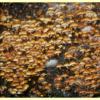
images/Xeromphalina/Xeromphalina_leonina_mccann.jpg

Diagnostic characters
Small agaric, growing on wood, with a white spore print. Pileus brown, not viscid. Lamellae subdecurrent or decurrent, rarely adnate. Stipe central. Partial veil remnants absent. Spores hyaline, amyloid, smooth; germ pore absent. Cheilocystidia present, not nodulose or diverticulate. Lamellar trama regular. Pileipellis a cutis. Clamp connections present.
Similar genera
The single known Australian species is quite distinctive in the field because it grows in masses on wood, and has a rather small, yellowish brown pileus with a depressed to umbilicate centre and decurrent lamellae. The stipe base often has strigose hairs, and there can be copious brownish rhizomorphs. Some Mycena grow on wood and have decurrent lamellae, but the stipe is not as tough as in Xeromphalina and the pileipellis has nodulose hyphae. Heimiomyces is closely related, but the Australian species differ in often being larger, with a more collybioid habit, and in having a rounded (rather than depressed) pileus, adnexed to adnate lamellae and usually diverticulate cheilocystidia.
Citation
Xeromphalina Kühner & Maire, in Konrad & Maublanc, Icon. Select. Fung. 6: 236 (1934).
Australian species
One named species: Xeromphalina leonina.
Australian distribution
W.A., Vic. and Tas. (and possibly also N.T., Qld and N.S.W.).
Habitat
In native forests, or sometimes on old eucalypt wood in pine plantations.
Substrate
On wood.
Trophic status
Saprotrophic.
References
Fuhrer, B. (2005), A Field Guide to Australian Fungi. Bloomings Books, Hawthorn. [Description and Illustration of X. leonina]
Horak, E. (1979d), Xeromphalina and Heimiomyces in Indomalaya and Australasia, Sydowia. 32: 131–153. [Key to Australasian and Indomalayan species and Description, Microcharacters and B&W Illustration of X. leonina and four other species, including two from New Zealand]
McCann, I.R. (2003), Australian Fungi Illustrated. Macdown Productions, Vermont. [Illustration of X. leonina]
